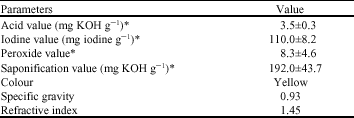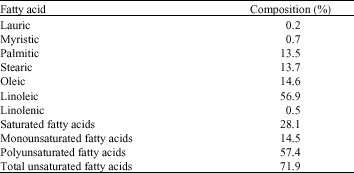Research Article
Physicochemical Properties and Fatty Acid Composition of Citrullus lanatus (Egusi Melon) Seed Oil
Department of Biochemistry, University of Benin, Benin City, Nigeria
Y.R. Ogunlowo
Department of Chemistry, Federal University of Technology, Akure, Ondo State, Nigeria
G.C. Ojieh
Department of Medical Biochemistry, College of Medicine, Ambrose Alli University, Ekpoma, Edo State, Nigeria
K.E. Adebisi
Department of Biochemistry, University of Benin, Benin City, Nigeria
G.O. Eidangbe
Department of Medical Biochemistry, College of Medicine, Ambrose Alli University, Ekpoma, Edo State, Nigeria
I.O. Isiosio
Department of Biochemistry, University of Benin, Benin City, Nigeria










